The Impact of Waxy Wheat Flour, Inulin and Guar Gum on Post-Prandial Glycaemic and Satiety Indices, Sensory Attributes and Shelf Life of Tandoori and Pita Breads
Abstract
:1. Introduction
2. Material and Methods
2.1. Experimental Design
2.2. Glycaemic Index Assay of Bread (In Vivo)
2.3. Satiety Assessment
2.4. Shelf Life Assessment (Staling)
2.5. Sensory Evaluation
2.6. Statistical Analysis
3. Results
3.1. In Vivo Measurement of the GI of Breads
3.2. Satiety Index Test
3.3. Shelf Life: Texture Properties of Breads during Storage Time
4. Discussion
4.1. In Vivo Measurement of the GI of Breads
4.2. Satiety Index Test
4.3. Shelf Life: Texture Properties of Bread during Storage Time
4.4. Sensory Assessment of Breads
5. Conclusions
Author Contributions
Funding
Institutional Review Board Statement
Informed Consent Statement
Data Availability Statement
Acknowledgments
Conflicts of Interest
References
- Barber, T.M.; Kabisch, S.; Pfeiffer, A.F.H.; Weickert, M.O. The Health Benefits of Dietary Fibre. Nutrients 2020, 12, 3209. [Google Scholar] [CrossRef] [PubMed]
- Galali, Y.; Omar, Z.A.; Sajadi, S.M. Biologically active components in by-products of food processing. Food Sci. Nutr. 2020, 8, 3004–3022. [Google Scholar] [CrossRef] [PubMed]
- Al-Dmoor, H.M.; Galali, Y. Novelty Formulas of Free Gluten Flat Bread for Coeliac Disease Patients. World J. Med. Sci. 2014, 11, 306–311. [Google Scholar]
- Purhagen, J.K.; Sjöö, M.E.; Eliasson, A.C. Fibre-rich additives—The effect on staling and their function in free-standing and pan-baked bread. J. Sci. Food Agric. 2012, 92, 1201–1213. [Google Scholar] [CrossRef] [PubMed]
- Tudoricǎ, C.M.; Kuri, V.; Brennan, C.S. Nutritional and physicochemical characteristics of dietary fiber enriched pasta. J. Agric. Food Chem. 2002, 50, 347–356. [Google Scholar] [CrossRef]
- Mudgil, D.; Barak, S.; Khatkar, B.S. Guar gum: Processing, properties and food applications—A Review. J. Food Sci. Technol. 2014, 51, 409–418. [Google Scholar] [CrossRef] [Green Version]
- Fujita, S.; Kumagai, T.; Yanagimachi, M.; Sakuraba, S.; Sanpei, R.; Yamoto, M.; Tohara, H. Waxy wheat as a functional food for human consumption. J. Cereal Sci. 2012, 55, 361–365. [Google Scholar] [CrossRef]
- Galali, Y.; Rees, G.; Kuri, V. Study the influence of waxy wheat flour, inulin and guar gum on quality and microstructure of Pita and Tandoori breads: Response surface methodology aids functional food development. J. Food Sci. Technol. 2022, 59, 1372–1383. [Google Scholar] [CrossRef]
- FAO. The Role of the Glycemic Index in Food Choice. Available online: http://www.fao.org/3/w8079e/w8079e0a.htm (accessed on 30 May 2013).
- Ou, S.; Kwok, K.; Li, Y.; Fu, L. In Vitro study of possible role of dietary fiber in lowering postprandial serum glucose. J. Agric. Food Chem. 2001, 49, 1026–1029. [Google Scholar] [CrossRef]
- Butt, M.S.; Shahzadi, N.; Sharif, M.K.; Nasir, M. Guar gum: A miracle therapy for hypercholesterolemia, hyperglycemia and obesity. Crit. Rev. Food Sci. Nutr. 2007, 47, 389–396. [Google Scholar] [CrossRef]
- Aravind, N.; Sissons, M.J.; Fellows, C.M.; Blazek, J.; Gilbert, E.P. Effect of inulin soluble dietary fibre addition on technological, sensory, and structural properties of durum wheat spaghetti. Food Chem. 2012, 132, 993–1002. [Google Scholar] [CrossRef]
- Manno, D.; Filippo, E.; Serra, A.; Negro, C.; De Bellis, L.; Miceli, A. The influence of inulin addition on the morphological and structural properties of durum wheat pasta. Int. J. Food Sci. Technol. 2009, 44, 2218–2224. [Google Scholar] [CrossRef]
- Papathanasopoulos, A.; Camilleri, M. Dietary Fiber Supplements: Effects in Obesity and Metabolic Syndrome and Relationship to Gastrointestinal Functions. Gastroenterology 2010, 138, 65–72. [Google Scholar] [CrossRef] [PubMed] [Green Version]
- Vosloo, M. Some factors affecting the digestion of glycaemic carbohydrates and the blood glucose response. J. Consum. Sci. 2010, 33. [Google Scholar] [CrossRef]
- Carter, P.; Khunti, K.; Davies, M.J. Dietary recommendations for the prevention of type 2 diabetes: What are they based on? J. Nutr. Metab. 2012, 2012, 847202. [Google Scholar] [CrossRef] [Green Version]
- Kovacs, E.; Westerterp-Plantenga, M.; Saris, W.; Melanson, K.; Goossens, I.; Geurten, P.; Brouns, F. The effect of guar gum addition to a semisolid meal on appetite related to blood glucose, in dieting men. Eur. J. Clin. Nutr. 2002, 56, 771–778. [Google Scholar] [CrossRef] [Green Version]
- Clark, M.J.; Slavin, J.L. The effect of fiber on satiety and food intake: A systematic review. J. Am. Coll. Nutr. 2013, 32, 200–211. [Google Scholar] [CrossRef]
- Fiszman, S.; Varela, P. The role of gums in satiety/satiation. A review. Food Hydrocoll. 2013, 32, 147–154. [Google Scholar] [CrossRef]
- Hutchison Emilien, C. The Effects of Non-Viscous, Fermentable Fibers on Appetite and Food Intake in Healthy Adults. Ph.D. Thesis, Iowa State University, Ames, IA, USA, 2015. [Google Scholar]
- Angioloni, A.; Collar, C. Bread crumb quality assessment: A plural physical approach. Eur. Food Res. Technol. 2009, 229, 21–30. [Google Scholar] [CrossRef]
- Angioloni, A.; Collar, C. Gel, dough and fibre enriched fresh breads: Relationships between quality features and staling kinetics. J. Food Eng. 2009, 91, 526–532. [Google Scholar] [CrossRef]
- Ghodke, S.K. Effect of Guar Gum on Dough Stickiness and Staling in Chapatti-An Indian Unleavened Flat Bread. Int. J. Food Eng. 2009, 5. [Google Scholar] [CrossRef]
- Selomulyo, V.O.; Zhou, W. Frozen bread dough: Effects of freezing storage and dough improvers. J. Cereal Sci. 2007, 45, 1–17. [Google Scholar] [CrossRef]
- Rodge, A.B.; Sonkamble, S.M.; Salve, R.V.; Hashmi, S.I. Effect of Hydrocolloid (guar gum) Incorporation on the Quality Characteristics of Bread. J. Food Process. Technol. 2012, 3. [Google Scholar]
- Garimella Purna, S.K.; Miller, R.A.; Seib, P.A.; Graybosch, R.A.; Shi, Y.C. Volume, texture, and molecular mechanism behind the collapse of bread made with different levels of hard waxy wheat flours. J. Cereal Sci. 2011, 54, 37–43. [Google Scholar] [CrossRef] [Green Version]
- Zahn, S.; Pepke, F.; Rohm, H. Effect of inulin as a fat replacer on texture and sensory properties of muffins. Int. J. Food Sci. Technol. 2010, 45, 2531–2537. [Google Scholar] [CrossRef]
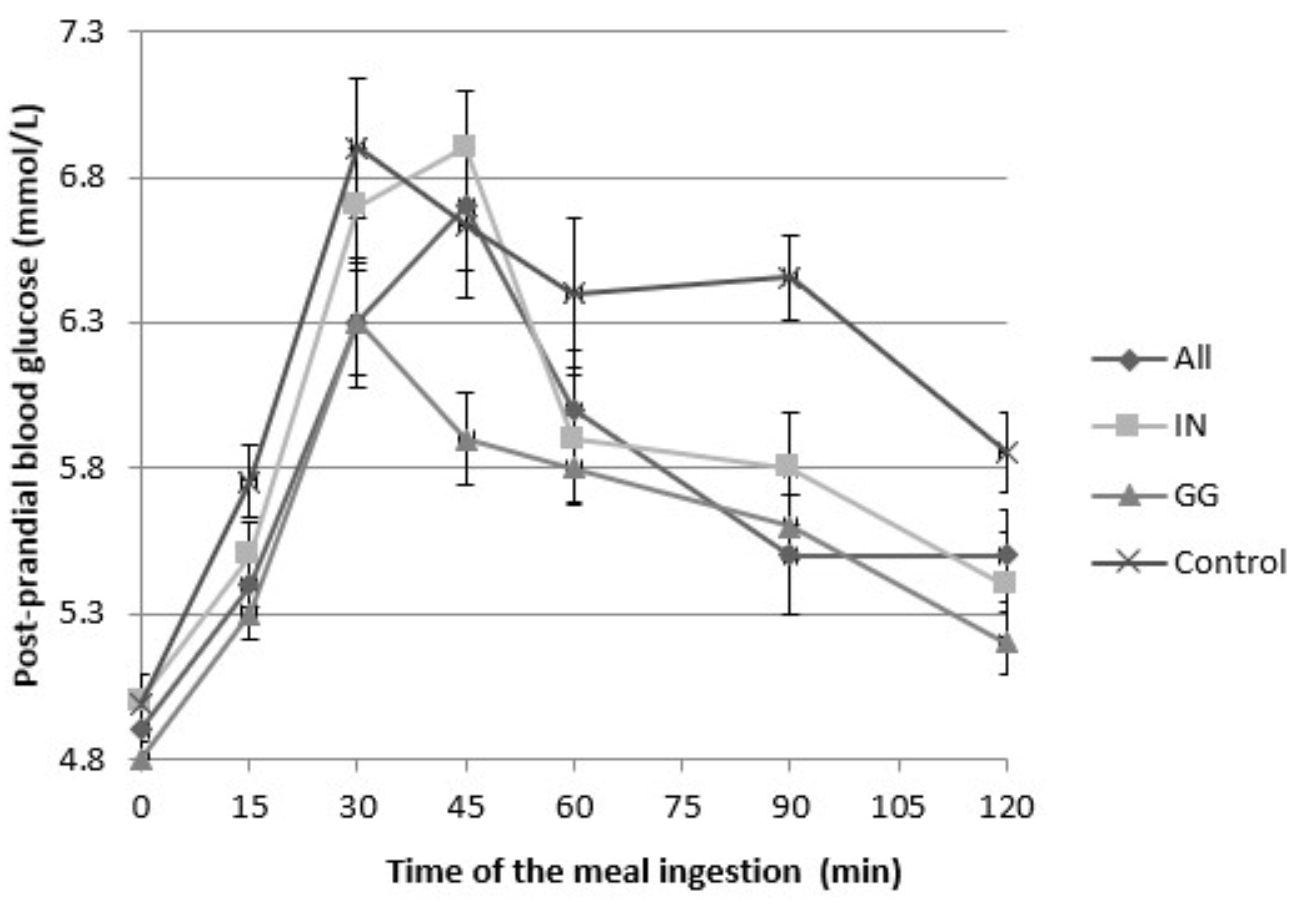
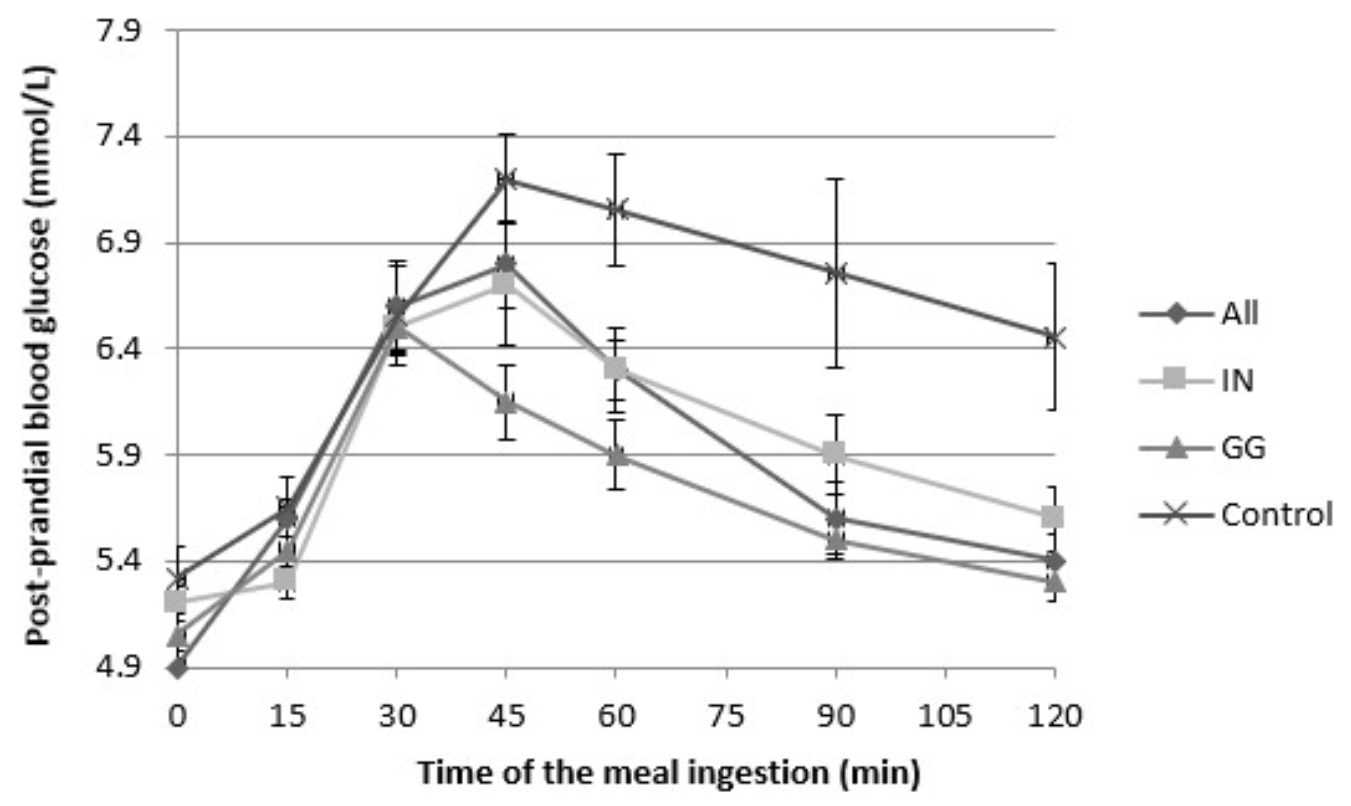
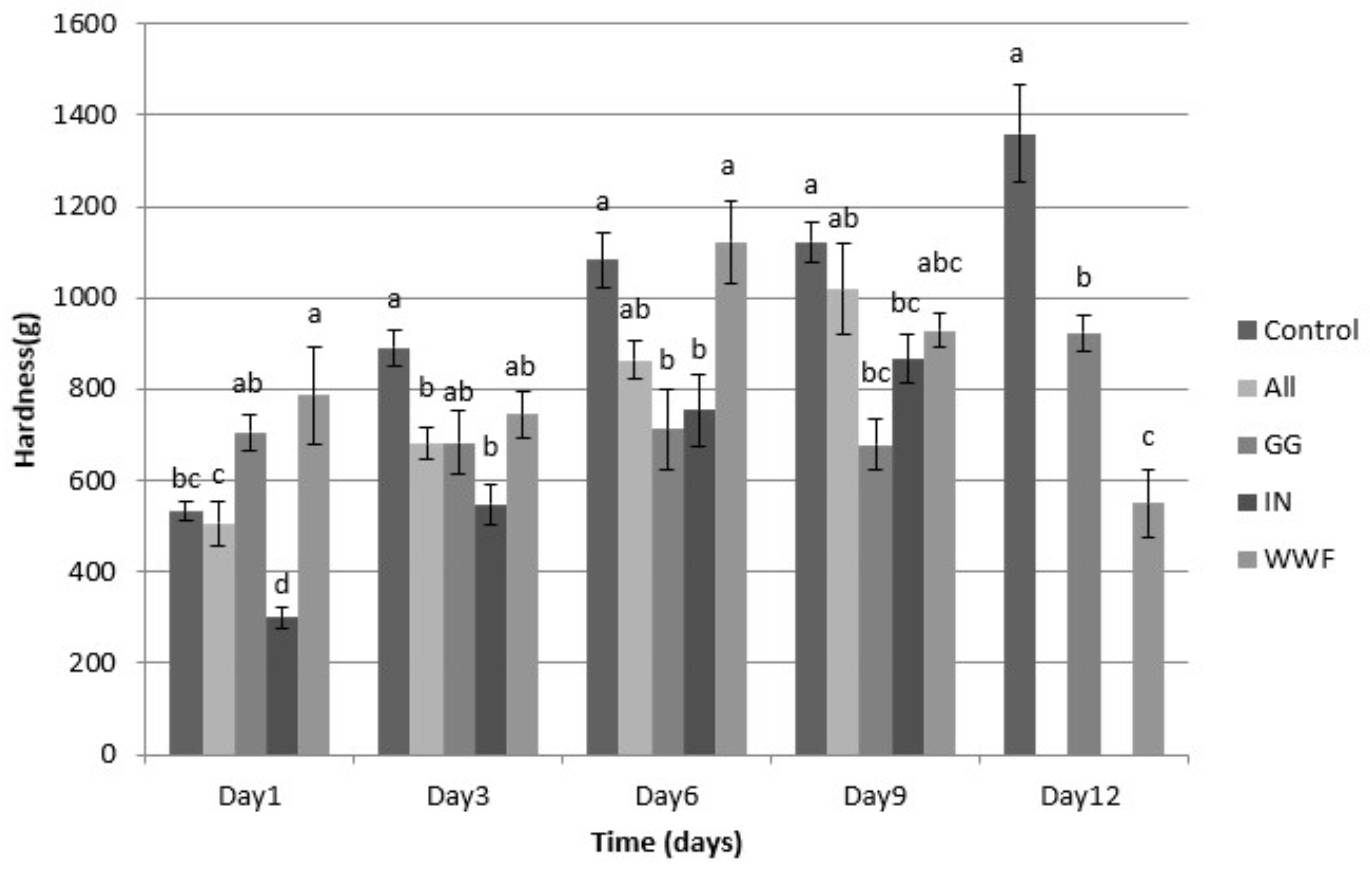
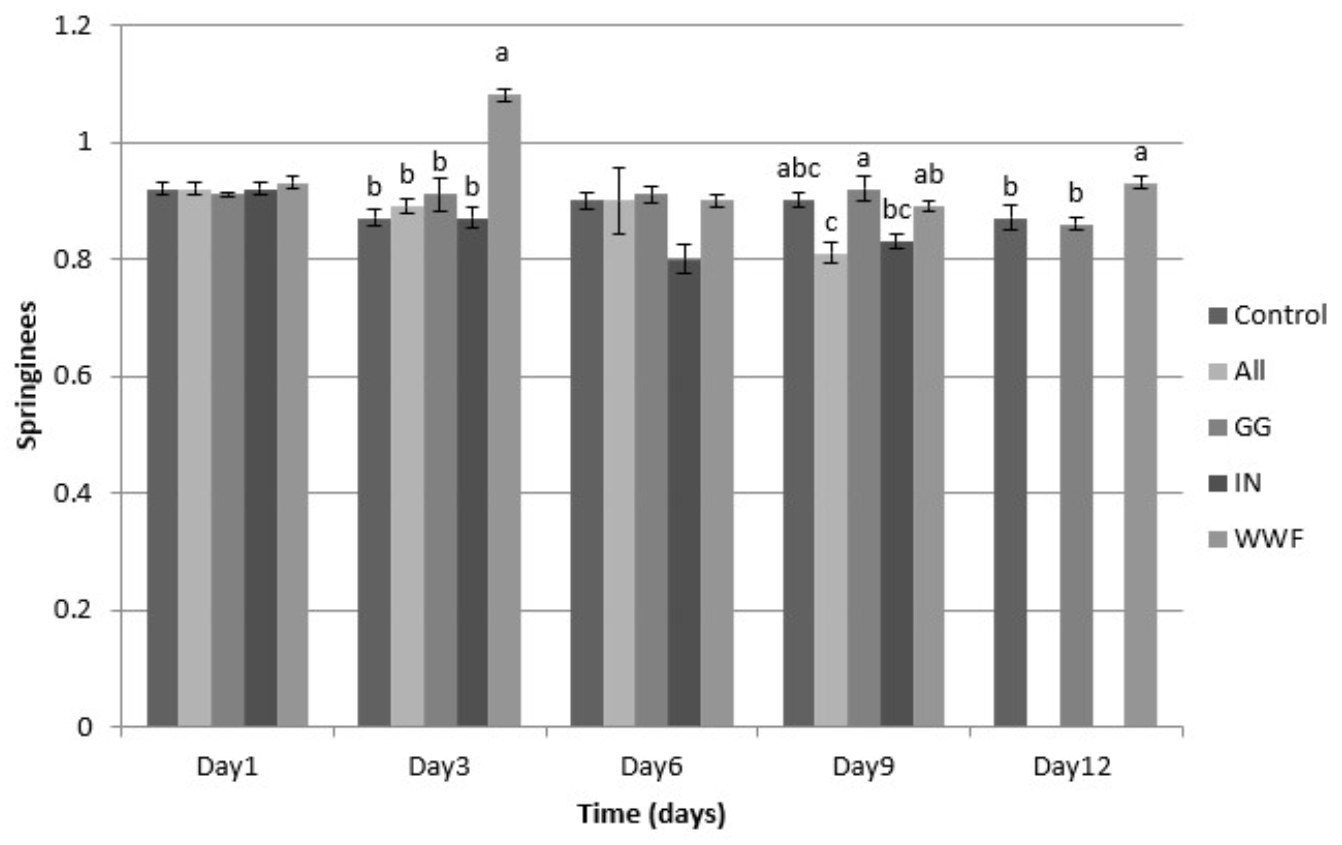
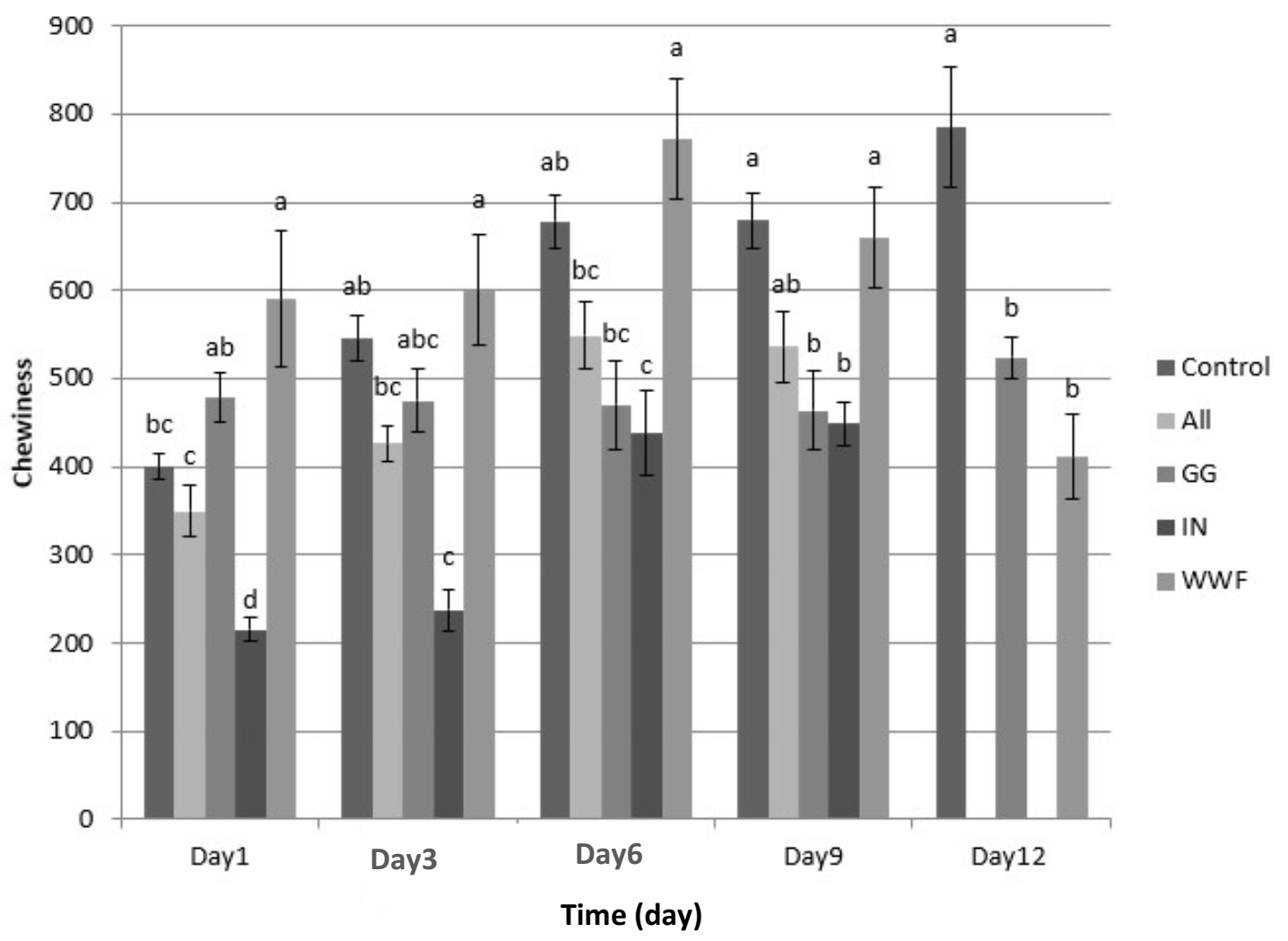
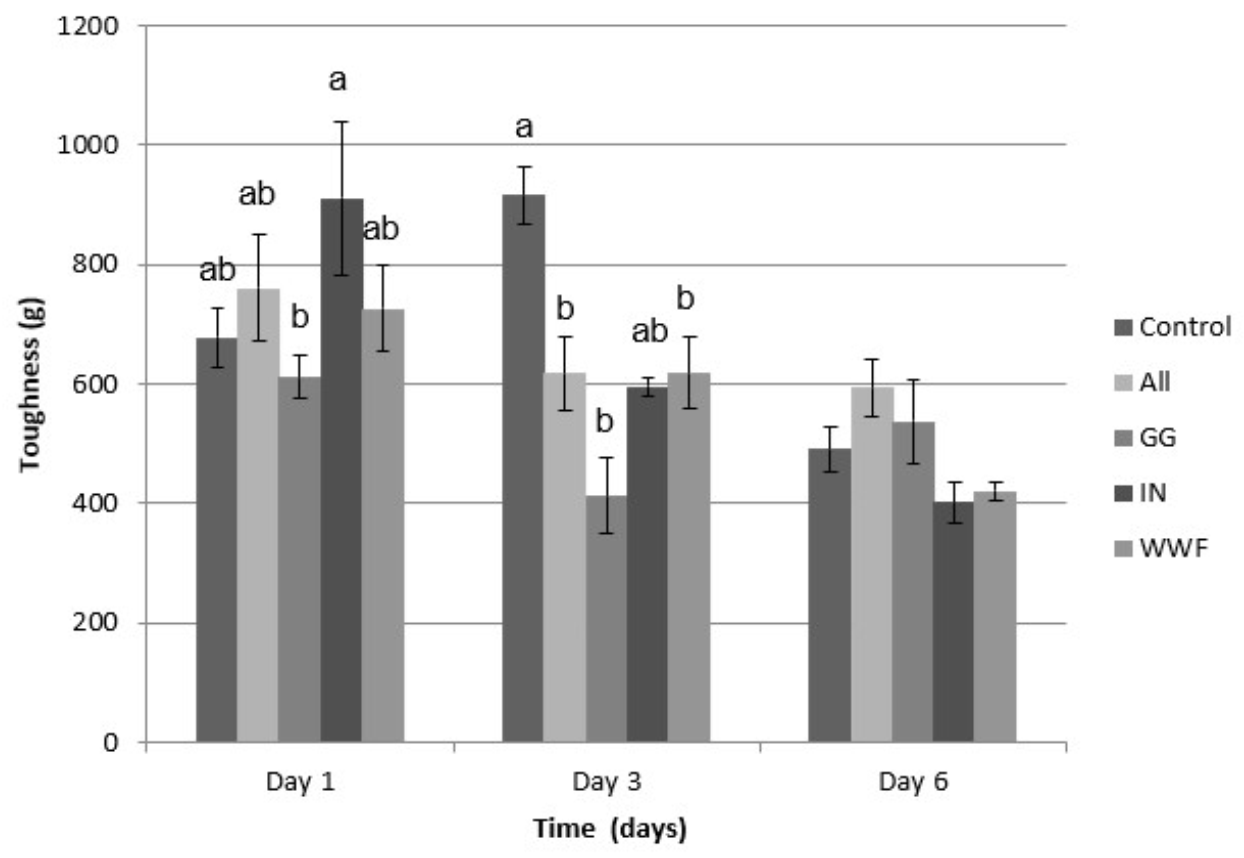

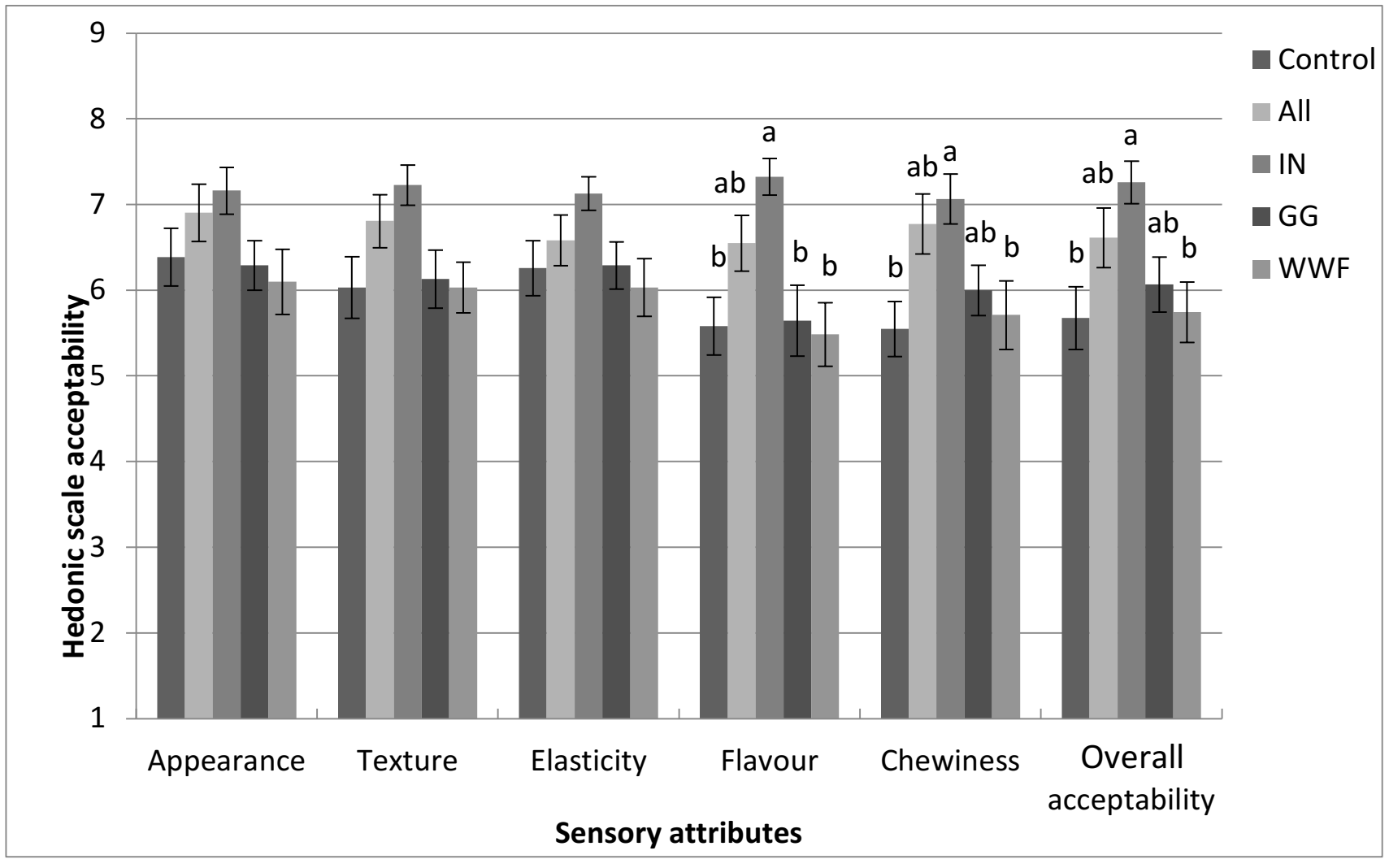
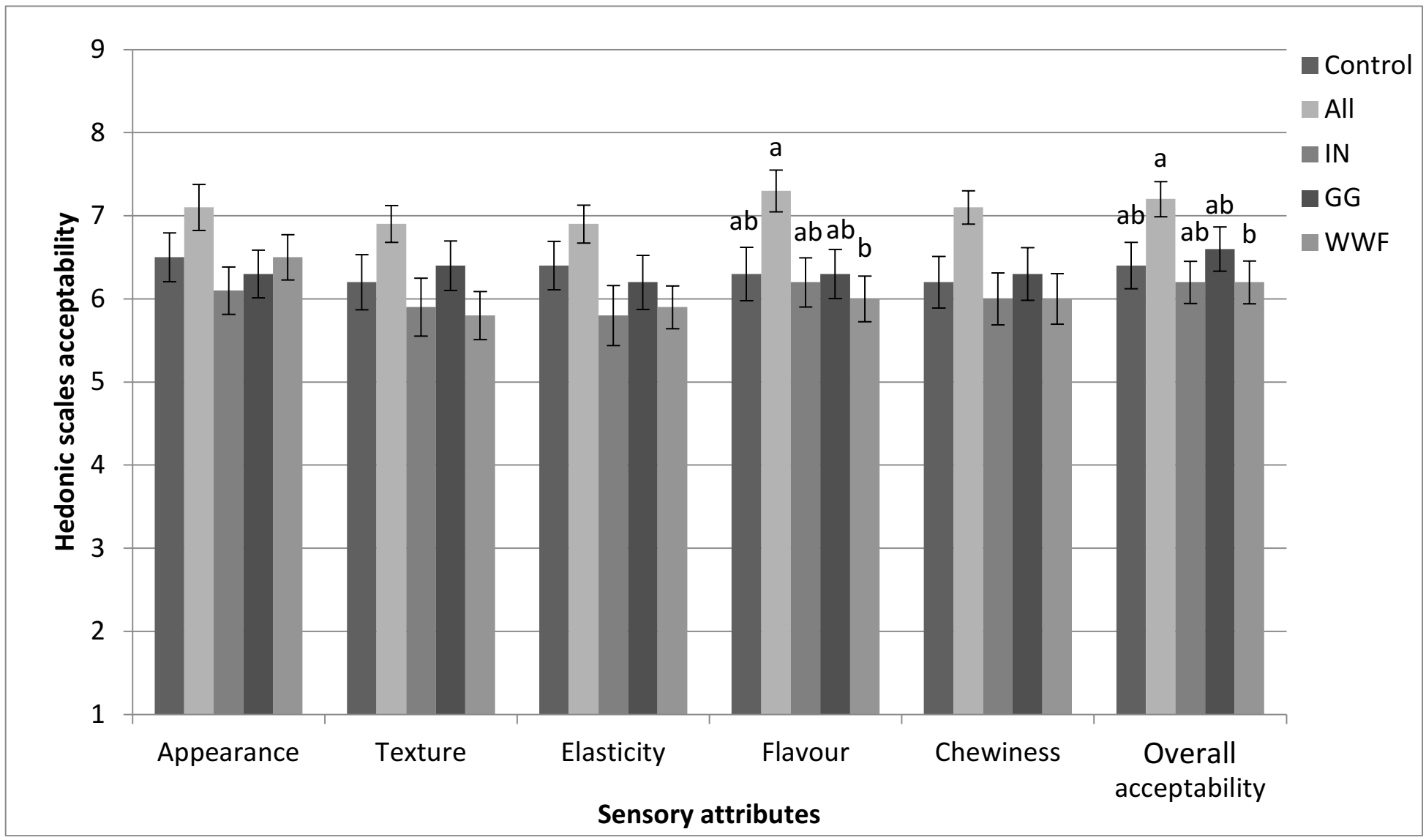
| Treatments | Proportions of FI | ||
|---|---|---|---|
| WWF (%) | IN (%) | GG (%) | |
| Control | 0 | 0 | 0 |
| All FI | 7.5 | 4 | 1 |
| IN | 0 | 8 | 0 |
| GG | 0 | 0 | 2 |
| WWF | 15 | 0 | 0 |
| No. | Gender | Mean Age (Year) | Mean BMI (kg/m2) |
|---|---|---|---|
| Total 9 volunteers | 7 males 2 Female | 35.7 ± 10.7 | 22.4 ± 7.8 |
| Bread Types | Samples | Time of the Meal Ingestion (min) | ||||||||||
|---|---|---|---|---|---|---|---|---|---|---|---|---|
| 0 | 15 | 30 | 45 | 60 | 90 | 120 | G AUC | GI | S AUC | SI | ||
| % | % | |||||||||||
| Pita | Control | 5.0 | 5.8 | 6.9 | 6.7 | 6.6 | 6.2 | 5.8 | 161 + 38 a | 100 | 355 + 110 a | 104 |
| All | 4.9 | 5.4 | 6.3 | 6.7 | 6.0 | 5.5 | 5.5 | 102 + 34 b | 63 | 418 + 110 a | 122 | |
| IN | 5.0 | 5.5 | 6.7 | 6.9 | 5.9 | 5.8 | 5.4 | 92 + 27 b | 57 | 451 + 66 a | 132 | |
| GG | 4.8 | 5.3 | 6.3 | 5.9 | 5.8 | 5.6 | 5.2 | 89 + 38 b | 55 | 452 + 71 a | 132 | |
| Tandoori | Control | 5.8 | 5.7 | 6.6 | 7.7 | 6.9 | 7.5 | 6.9 | 162 + 51 a | 100 | 329 + 100 a | 96 |
| All | 4.9 | 5.6 | 6.6 | 6.8 | 6.3 | 5.6 | 5.4 | 120 + 37 a | 74 | 420 + 117 a | 123 | |
| IN | 5.2 | 5.3 | 6.5 | 6.7 | 6.3 | 5.9 | 5.6 | 98 + 32 b | 60 | 381 + 86 a | 111 | |
| GG | 5.5 | 5.5 | 6.5 | 6.2 | 5.9 | 5.5 | 5.3 | 92. +45 b | 57 | 390 + 56 a | 114 | |
Publisher’s Note: MDPI stays neutral with regard to jurisdictional claims in published maps and institutional affiliations. |
© 2022 by the authors. Licensee MDPI, Basel, Switzerland. This article is an open access article distributed under the terms and conditions of the Creative Commons Attribution (CC BY) license (https://creativecommons.org/licenses/by/4.0/).
Share and Cite
Galali, Y.; Rees, G.; Kuri, V. The Impact of Waxy Wheat Flour, Inulin and Guar Gum on Post-Prandial Glycaemic and Satiety Indices, Sensory Attributes and Shelf Life of Tandoori and Pita Breads. Appl. Sci. 2022, 12, 3355. https://doi.org/10.3390/app12073355
Galali Y, Rees G, Kuri V. The Impact of Waxy Wheat Flour, Inulin and Guar Gum on Post-Prandial Glycaemic and Satiety Indices, Sensory Attributes and Shelf Life of Tandoori and Pita Breads. Applied Sciences. 2022; 12(7):3355. https://doi.org/10.3390/app12073355
Chicago/Turabian StyleGalali, Yaseen, Gail Rees, and Victor Kuri. 2022. "The Impact of Waxy Wheat Flour, Inulin and Guar Gum on Post-Prandial Glycaemic and Satiety Indices, Sensory Attributes and Shelf Life of Tandoori and Pita Breads" Applied Sciences 12, no. 7: 3355. https://doi.org/10.3390/app12073355
APA StyleGalali, Y., Rees, G., & Kuri, V. (2022). The Impact of Waxy Wheat Flour, Inulin and Guar Gum on Post-Prandial Glycaemic and Satiety Indices, Sensory Attributes and Shelf Life of Tandoori and Pita Breads. Applied Sciences, 12(7), 3355. https://doi.org/10.3390/app12073355








